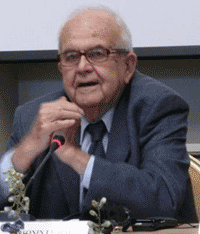Dear friends and colleagues,
I did not come here to bury your beautiful enterprise, but to praise it. That is why you are not going to listen to me reading a prepared speech that will last indefinitely. Instead we have agreed that I will talk freely about a few things of interest to most of us, and that it will not take more than half an hour.

First a few words about history: as many of you know, in the early 1950s there was a journal in Prague called Literární noviny (Literary Gazette), a title that was copied from Literaturna Gazeta in Moscow. It was not very different from other publications of that period.
After 1956, things changed – or started to change. People who worked with the journal decided to open the doors and the windows to let in as much fresh air as possible. Very quickly they realized that this could not be done without communication with the outside world. The outside world was Europe, but not only Europe. Over the years, Literární noviny transformed completely and became something like a vehicle for what became known as the “Czechoslovak Spring”. The journal was praised everywhere; when I eventually landed in the United States I realized that it was known even there, despite the fact that nobody could read it. Hearsay is always important.
So we started to bring the outside world to this journal and through the journal to the country – and this changed many things. During communist rule, the journal printed and sold 130,000 copies and in 1968 almost 300,000 copies in a country of 15 million.
When, after the Soviet invasion of Czechoslovakia, I landed in Paris, I thought that a journal that brought together European cultures from the East and the West, from the North and the South, could become something quite meaningful. The problem was that there was no money, and there were very few people who understood what I was talking about. In the meantime I left for the United States, where I stayed for more than a decade, but the idea of a journal pursued me and did not let me sleep. Eventually we found some money: very little, but enough for a room with a kitchen. Though we had no publisher, we started publishing what we called Lettre internationale, an allusion to the letters that circulated in Europe in the seventeenth century among friends, philosophers, people of culture and even politicians and rulers. While more or less secret, these letters helped change some ways of thinking.
After just a few years, and very much to our surprise, the journal, which had a very limited print run, no publisher and no money, appeared in ten editions all over Europe. The different editions were independent, which means that everybody did what they thought was important in their respective countries. However, we had a sort of central address, we circulated texts that came from all around Europe. The idea behind it all was that various European cultures actually had a little contact with each other. What do the French know about Finnish culture? Not to mention Lithuanian culture. And what do the Finns know about Portuguese culture? Not about Nobel prize winners, but about the lives and the dynamics of each of these cultures? Not much. We believed that this should be changed.
A second premise was to show the readers of the journal around Europe that behind the Iron Curtain culture was very much alive, and that it could become an important instrument in changing not only society, but also the way people think, and even influence political change. This, I believe, was the achievement of this journal, which was called Lettre internationale everywhere, but which was of course an internationally anchored national journal wherever it was published.
After the fall of the Berlin Wall, the journal was also published in the East: in Poland, in Hungary, in Czechoslovakia, in Romania, even in Serbia and Croatia, in other words the former Yugoslavia. Some of these editions still exist – the Hungarian one, the Romanian; some died – the Czech one, the Polish, the Yugoslavian of course. It was the same in the West. Why did they fail to survive? Some would say that we no longer need an international journal that aims at bringing together the two Europes, East and West, serving as a go-between. Now we can do it by ourselves, they say. Well, as we know by now – just read the newspapers, watch television, listen to the radio – these two sides of Europe still know very little about each other. How many people in the West understand what is going on in Lithuania, in the Czech Republic, in Russia? And the other way round: in the East, the image of the West (not only of Europe) is schematic, limited, superficial. This, I believe is where you all come in. Lettre internationale accomplished its task in the late 1990s. Where it survives today, it is still interesting, but it does not have the same role as it did in the 1980s and in the 1990s. Not only because of the technological development, but of the development of the world as such.
What are we facing now? What task should you, as European cultural journals, take on? I am often asked: “Is there a European culture?” An interesting question. I believe – I’ve always believed – that the great strength of Europe, the characteristic quality of Europe, is that it is made up of forty different languages and cultures. There is one market; there is, at least in a large part of Europe, one currency; one day there might even be some sort of framework for a European policy. But the various European cultures will continue to have their own identities and this will remain the trademark that makes up Europe. For this is Europe’s identity: 350 million people, forty cultures and languages. I like this classic quote: “Culture begins where memory ends” or “Culture is what remains when all else is forgotten”. If you look at Europe from the outside you realize very quickly that despite different identities, there is a common cultural heritage that reaches far back, behind and beyond the reach of our memory. We are all enclosed in this culture and everybody recognizes that we are European, that we are not American, not Asian, not African. We are European, whether we come from England or Lithuania, from France or Greece.
Everywhere within each of these cultures there are two cultures: there is what the French philosopher and sociologist Edgar Morin calls a mass culture and a cultivated culture. Both these cultures are part of the overall identity of a culture, but they are different. Mass culture is self-sufficient; it can even be affluent, it can quickly earn a lot of money. Cultivated culture has rarely done so, and will not do so before time confirms its value and its importance. But cultivated culture is the soul of the Europe I described and of European cultures. The problem is that it has always had to be supported by public, royal, or private money. That is what enabled us to inherit it. The question then arises as to what we do today, when cultivated culture has become marginalized, in the East and in the West; when its role in society has been relegated and no one making political decisions cares about it?
In today’s Europe, in the European Union, the idea is to reduce cultivated culture to a common denominator, like any other commodity on the market. But this can’t be done with culture – not without hurting and harming the multiple European identities. In times of recession, in a period of crisis, this becomes dramatic. Find yourself sponsors, we are told. Sponsors will support you and help you – if it brings them something that is. Everyone asks, “What’s in it for me?” What could be in it for them is publicity (and sometimes tax deductions). But cultivated culture rarely brings enough publicity for a private sponsor. That is why another sponsor must take over. That sponsor is society. It can be the government, but above all different strata of society. And we must try to help society to understand why. How can we do that?
The problem is that cultural journals – which perform an important role – cannot change things by themselves. They have to find allies. Such allies are not only to be found in the field of the written word; they are in theatre, in film, in art, in television and radio. All these branches of cultural development and life have organizations comparable to Eurozine. I believe that these organizations should work together and together put pressure on their own societies and on the European Union.
Cultural journals are not something that decision-makers like very much. They are more like the mirror in the tale of Snow White. As long as the mirror shows you that you are beautiful and young, it is welcome; if it does not, you break it, destroy it and let it perish.
Eurozine is part of the potential of a much bigger scene to which it should eventually pay attention and try to organize something like a Eurozine for culture in a very broad sense, first of all for the cultivated cultures in Europe. In Prague in 1989, theatres and cinemas closed down, there was a strike. You might say that theatres and cinemas are of little political importance, but it developed into an important political act.
Such a movement must be very large and very well organized. It is one thing to dream, to have ideas. We all have them. We all know what should and shouldn’t be. But then comes the uninteresting work, the daily grind, which may not have much to do with big ideas and grand cultural, philosophical or social projects, but just organizing and getting people together who want to keep their ideas alive. This gruelling work may not be terribly interesting – we prefer to move in a field of dreams, ideas and art and beauty – but we must not neglect it. This enormous work that you all have to take upon yourselves is essential if you really wish to bring about a movement like Eurozine, where people from all over Europe, from different fields of culture, can start to act together.
This article is based on the opening address at the Eurozine conference ‘European histories’, held in Vilnius from 8 to 11 May 2009.








